Experimental Study on Engineering Characteristics of High-Speed Railway Subgrade Filler in Island Permafrost Regions
Abstract
1. Introduction
2. Test Materials and Methods
2.1. Test Materials
2.2. Test Equipment
- (1)
- Frost heave test
- (2)
- Permeability test
- (3)
- Strength test
2.3. Test Plan
3. Results and Analysis
3.1. Frost Heave Rate
3.1.1. Influence of Curing Time
3.1.2. Influence of Freeze–Thaw Cycle
3.2. Permeability Coefficient
3.2.1. Influence of Curing Time
3.2.2. Influence of Freeze–Thaw Cycle
3.3. Compressive Strength
3.3.1. Influence of Curing Time
3.3.2. Influence of Freeze–Thaw Cycle
4. Discussion
4.1. Field Test
4.2. Improving Mechanism
- (1)
- Ion exchange and adsorption
- (2)
- Hardening condensation reaction
4.3. Limitations of This Study
5. Conclusions
- (1)
- The double action of the modifier and cement effectively fills the pores between coarse grained soil, forming a strong soil-particle-bonding structure. The frost heave rate of the 5% cement + 3% modifier improved filler under the influence of various test factors is the smallest. After 28 days of curing, the frost heave rate (0.20) is about 1/4 of that of pure filler. After six freeze–thaw cycles, the frost heave rate (0.51) is about 58% lower than that of pure filler, and the frost heave resistance effect is remarkable.
- (2)
- The modifier promotes the hydration reaction of cement and effectively seals the pores between coarse-grained soil. The permeability coefficient of the 5% cement + 3% modifier improved filler under the influence of various test factors is the lowest. After 28 days of curing, the permeability coefficient (0.0008 cm/s) is about two orders of magnitude lower than that of pure filler. After eight freeze–thaw cycles, its permeability coefficient (0.0026 cm/s) is one order of magnitude lower than that of pure filler, and its anti-permeability performance is the best.
- (3)
- The hardening condensation reaction of the improved coarse-grained soil generates stable crystalline minerals and forms the strong chemical bond network crystal structure. The compressive strength of the 5% cement + 3% modifier improved filler under the influence of various test factors is the largest. After 28 days of curing, the compressive strength (1.9 MPa) is about 1.3 times higher than 5% cement improved filler. After eight freeze–thaw cycles, its compressive strength (1.36 MPa) is about 1.6 times higher than 5% cement improved filler, and the compressive strength is greatly improved.
- (4)
- The modifier has a more significant influence on the engineering characteristics than the curing time and freeze–thaw cycles, and the engineering characteristics of the 5% cement + 3% modifier improved fillers are the best, which can provide technical reference for foundation treatment and engineering disease-prevention of HSR subgrade in island permafrost regions.
Author Contributions
Funding
Institutional Review Board Statement
Informed Consent Statement
Data Availability Statement
Conflicts of Interest
References
- Chamberlain, E.J.; Gow, A.J. Effect of freezing and thawing on the permeability and structure of soils. Eng. Geol. 1979, 13, 73–92. [Google Scholar] [CrossRef]
- Sun, X.K.; Zhou, L.H.; Ma, Y.H.; Zhu, Y.L.; Xie, X. The adaptive counter-measures against permafrost degradation in northeast China. J. Glaciol. Geocryol. 2009, 31, 532–539. [Google Scholar] [CrossRef]
- Hui, Z.; Yang, J.; Pierce, G.T. Laboratory study and predictive modeling for thaw subsidence in deep perma-frost. Sci. Cold Arid. Reg. 2021, 13, 95–106. [Google Scholar] [CrossRef]
- Sun, Z.-Z.; Ma, W.; Zhang, S.-J.; Mu, Y.-H.; Yun, H.-B.; Wang, H.-L. Characteristics of thawed interlayer and its effect on embankment settlement along the Qinghai-Tibet Railway in permafrost regions. J. Mt. Sci. 2018, 15, 1090–1100. [Google Scholar] [CrossRef]
- Tai, B.; Wu, Q.; Yue, Z.; Xu, H. Ground temperature and deformation characteristics of anti-freeze-thaw embankments in permafrost and seasonal frozen ground regions of China. Cold Reg. Sci. Technol. 2021, 189, 103331. [Google Scholar] [CrossRef]
- Hossain, B.; Roknuzzaman; Biswas, A.; Islam, M. Evaluation of engineering properties of thermal power plant waste for subgrade treatment. J. Civ. Eng. Sci. Technol. 2021, 12, 112–123. [Google Scholar] [CrossRef]
- Fentaw, M.; Alemayehu, E.; Geremew, A. Experimental study of stabilization of expansive soil using the mixture of marble dust, rice husk ash and cement for sub-grade road construction: A case study of Woldia town. J. Civ. Eng. Sci. Technol. 2021, 12, 141–159. [Google Scholar] [CrossRef]
- Zhu, S.; Tang, Y.; Xu, Q.; Zhang, K.; Li, H.; Zhu, Z.; Yin, W. Mechanical Properties Test and Enhancement Mechanism of Lime Soil Modified by High Content Soda Residue for Road Use. Coatings 2022, 12, 1539. [Google Scholar] [CrossRef]
- Yin, Z.; Lekalpure, R.L.; Ndiema, K.M. Experimental Study of Black Cotton Soil Stabilization with Natural Lime and Pozzolans in Pavement Subgrade Construction. Coatings 2022, 12, 103. [Google Scholar] [CrossRef]
- Ma, S.; Sun, Z.; Wei, J.; Zhang, X.; Zhang, L. Utilization of Modified Red Mud Waste from the Bayer Process as Subgrade and Its Performance Assessment in a Large-Sale Application. Coatings 2022, 12, 471. [Google Scholar] [CrossRef]
- Luo, Q.; Wu, P.; Wang, T. Evaluating frost heave susceptibility of well-graded gravel for HSR subgrade based on orthogonal array testing. Transp. Geotech. 2019, 21, 100283. [Google Scholar] [CrossRef]
- She, W.; Wei, L.; Zhao, G.; Yang, G.; Jiang, J.; Hong, J. New insights into the frost heave behavior of coarse grained soils for high-speed railway roadbed: Clustering effect of fines. Cold Reg. Sci. Technol. 2019, 167, 102863. [Google Scholar] [CrossRef]
- Wang, T.-L.; Yue, Z.-R.; Ma, C.; Wu, Z. An experimental study on the frost heave properties of coarse grained soils. Transp. Geotech. 2014, 1, 137–144. [Google Scholar] [CrossRef]
- Konrad, J.M.; Lemieux, N. Influence of fines on frost heave characteristics of a well-graded base-course material. Can. Geotech. J. 2005, 42, 515–527. [Google Scholar] [CrossRef]
- Uthus, L.; Hermansson, Å.; Horvli, I.; Hoff, I. A study on the influence of water and fines on the deformation properties of unbound aggregates. In Proceedings of the International Conferences on the Bearing Capacity of Roads, Railways and Airfields, Trondheim, Norway, 27-29 June 2005. [Google Scholar]
- Tanaka, T.; Haung, S.; Fukuda, M.; Bray, M.T.; Akagawa, S. A Study on Cold Region Pipeline Design Based on Full-Scale Experiment. In Proceedings of the 2008 7th International Pipeline Conference, Calgary, AL, Canada, 29 September-3 October 2008; 2008; Volume 48609, pp. 211–219. [Google Scholar] [CrossRef]
- Klinova, G.I.; Aksenov, V.I.; Dzhakhangirova, N.I. Thaw-induced deformation properties of frozen soils. Soil Mech. Found. Eng. 2010, 47, 102–107. [Google Scholar] [CrossRef]
- Bilodeau, J.P.; Dore, G.; Pierre, P. Gradation influence on frost susceptibility of base granular materials. Int. J. Pavement Eng. 2008, 9, 397–411. [Google Scholar] [CrossRef]
- Murton, J.B.; Ozouf, J.C.; Peterson, R. Heave, settlement and fracture of chalk during physical modelling experiments with temperature cycling above and below 0 °C. Geomorphology 2016, 270, 71–87. [Google Scholar] [CrossRef]
- Li, Y.; Ling, X.; Su, L.; An, L.; Li, P.; Zhao, Y. Experimental measurement and numerical simulation of frost heave in saturated coarse-grained soil. Cold Reg. Sci. Technol. 2017, 137, 68–74. [Google Scholar] [CrossRef]
- Long, X.; Cen, G.; Cai, L.; Chen, Y. Experimental Research on Frost Heave Characteristics of Gravel Soil and Multifactor Regression Prediction. Adv. Mater. Sci. Eng. 2018. [Google Scholar] [CrossRef]
- Wang, T.-L.; Wang, H.-H.; Song, H.-F.; Yue, Z.-R.; Guo, Z.-H. Effects of cement content and grain-size composition on engineering properties of high-speed-railway macadam subgrade. Cold Reg. Sci. Technol. 2018, 145, 21–31. [Google Scholar] [CrossRef]
- Cui, K.; Wu, G.; Du, Y.; An, X.; Wang, Z. Freeze–thaw durability of cement-stabilized macadam subgrade and its compaction quality index. Cold Reg. Sci. Technol. 2019, 160, 13–20. [Google Scholar] [CrossRef]
- Yang, G.T.; Gao, L.; Wang, T.L.; Lin, Y.Q. Experimental Study on Frost Heaving Properties of Cement Stabilized Macadam Subgrade Bed of High Speed Railway in Severe Cold Regions. China Railway Sci. 2016, 37, 1–10. [Google Scholar] [CrossRef]
- Wang, T.; Song, H.; Guo, Z.; Yue, Z.; Lin, Y. Freeze-thaw characteristics of subgrade macadam fillings influenced by cement content and grain-size composition. Chin. J. Geotech. Eng. 2017, 39, 2180–2186. [Google Scholar] [CrossRef]
- Wu, R.; Zhang, L.; Han, Z.; Fan, J. Long-term water immersion and freeze-thaw cycles experiment of cement-stabilized macadam bases. Huazhong Univ. Technol. 2011, 39, 113–115. [Google Scholar] [CrossRef]
- Zeng, M.; Xue, Z.; Gu, S.; Tan, B. Trial study on the pavement performance of open graded cement stabilized aggregate base. Beijing Univ. Technol. 2015, 41, 579–583. [Google Scholar] [CrossRef]
- Zhao, S.Y.; Yang, Y.K.; Li, F.H.; Cheng, J.Q.; Tian, J.Z. Research on cement-modified frost heave characteristics of high-speed railway subgrade. China Railw. 2014, 36, 71–75. [Google Scholar] [CrossRef]
- Zhao, G.; She, W.; Yang, G.; Li, P.; Cai, D.; Jiang, J.; Hao, H. Mechanism of cement on the performance of cement stabilized aggregate for high speed railway roadbed. Constr. Build. Mater. 2017, 144, 347–356. [Google Scholar] [CrossRef]
- Wang, Q.; Liu, J.; Zhu, X.; Liu, J.; Liu, Z. The experiment study of frost heave characteristics and gray correlation analysis of graded crushed rock. Cold Reg. Sci. Technol. 2016, 126, 44–50. [Google Scholar] [CrossRef]
- Han, K.; Liu, Y.; Xie, Y. Experimental Study on Frozen-Heave Influence Factors for Graded Gravel in Surface Layer of passenger Dedicated Line. In Proceedings of the AEIE 2015, Xiamen, China, 19–20 May 2015; CRC Press; p. 33. [Google Scholar]
- Li, X.; Li, X.; Wu, Y.; Wu, L.; Yue, Z. Selection criteria of mesh size and time step in FEM analysis of highly nonlinear unsaturated seepage process. Comput. Geotech. 2022, 146, 104712. [Google Scholar] [CrossRef]
- TB 10102-2010 Code for Soil Test of Railway Engineering; China Railway Publishing House Co., Ltd.: Beijing, China, 2011.
- Tang, W.J. Study on quality control of graded broken stone for railway subgrade engineering. J. Railw. Eng. Soc. 2013, 30, 36–40. [Google Scholar] [CrossRef]
- Jie, S.; Yue, Z.; Sun, T.C.; Yang, Z.H.; Zhang, H.B. Tests and model studies on the deterioration of freeze-thaw of cement-stabilized macadam subgrade bed in high speed railway. Technol. Eng. 2021, 21, 3318–3324. [Google Scholar] [CrossRef]
- Jie, S.; Yue, Z.; Sun, Z.; Zhang, H.; Hu, T.; Sun, T.; Yuan, L.; Xie, P.; Mao, S. Frost resistance and mechanical degradation characteristics of cement-stabilized macadam under the long-term freezing–thawing cycles. Constr. Build. Mater. 2022, 347, 128545. [Google Scholar] [CrossRef]
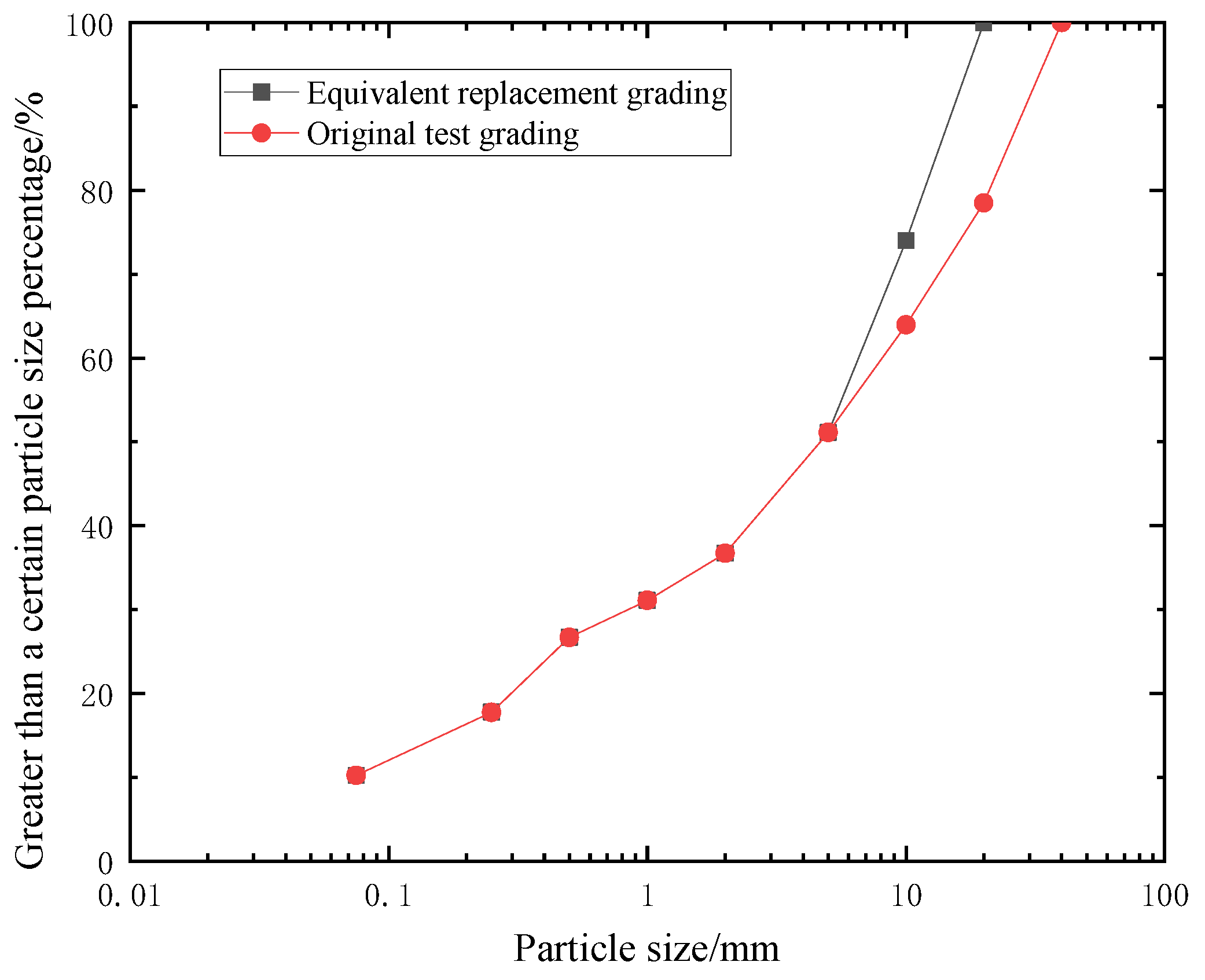
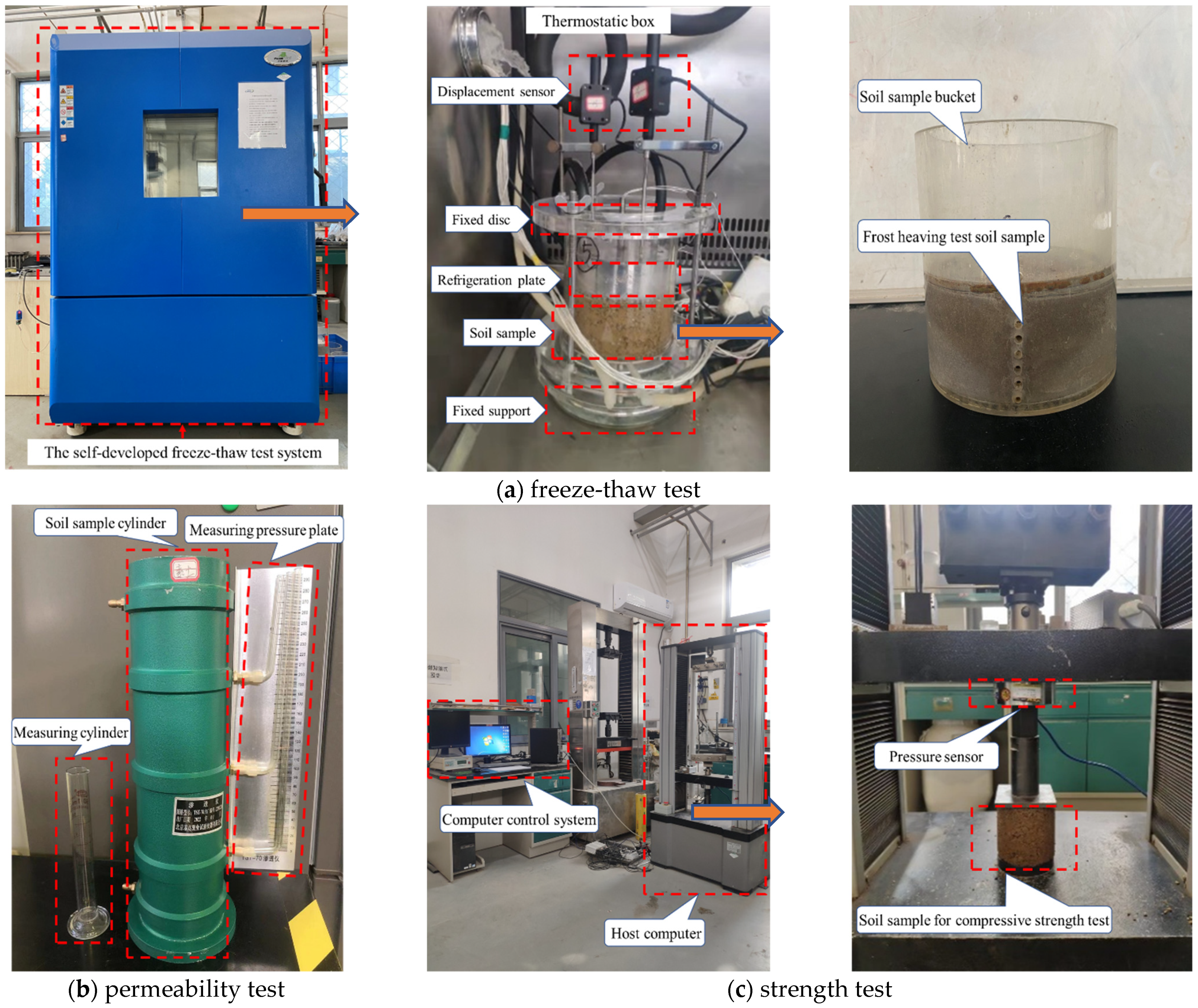
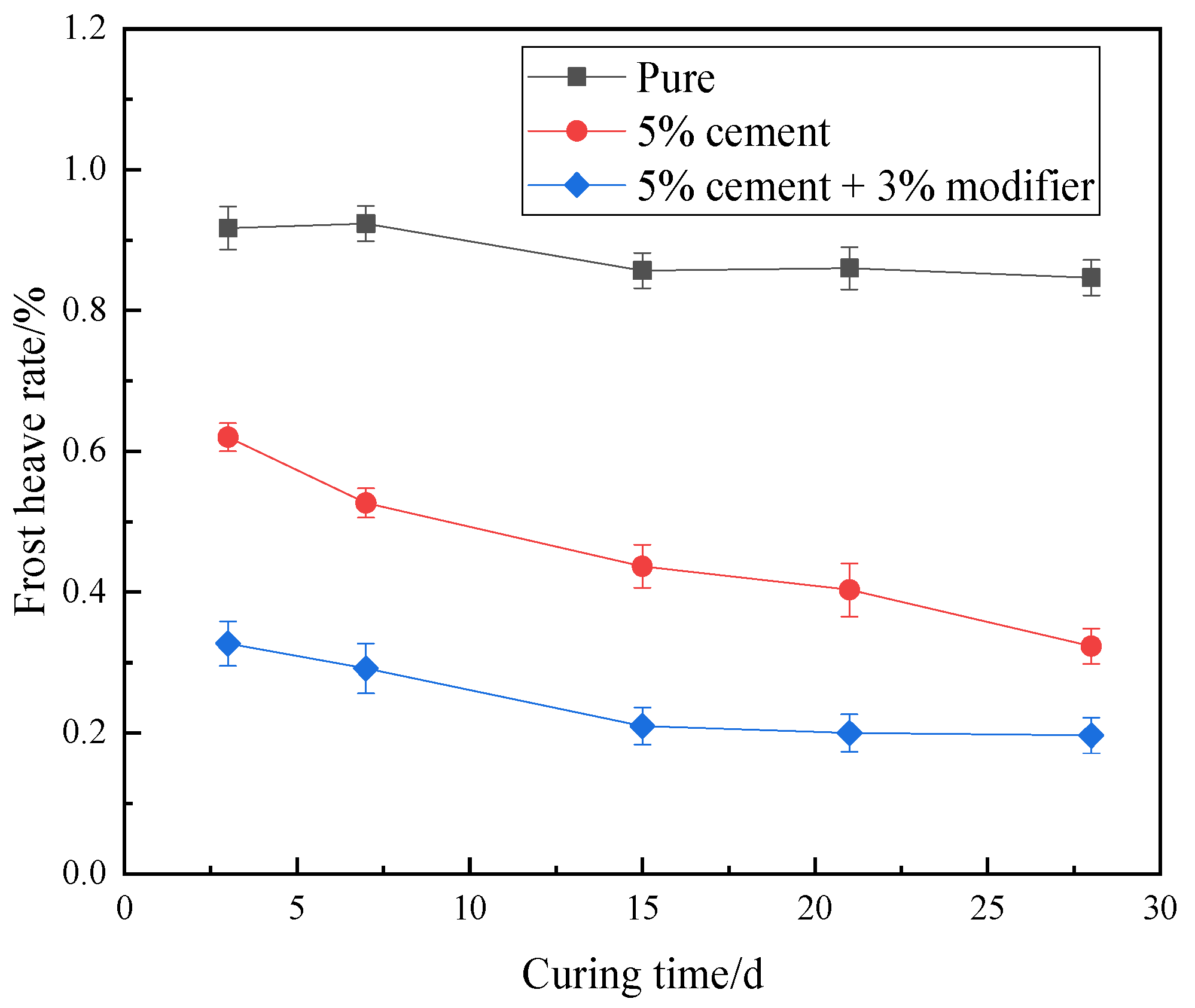
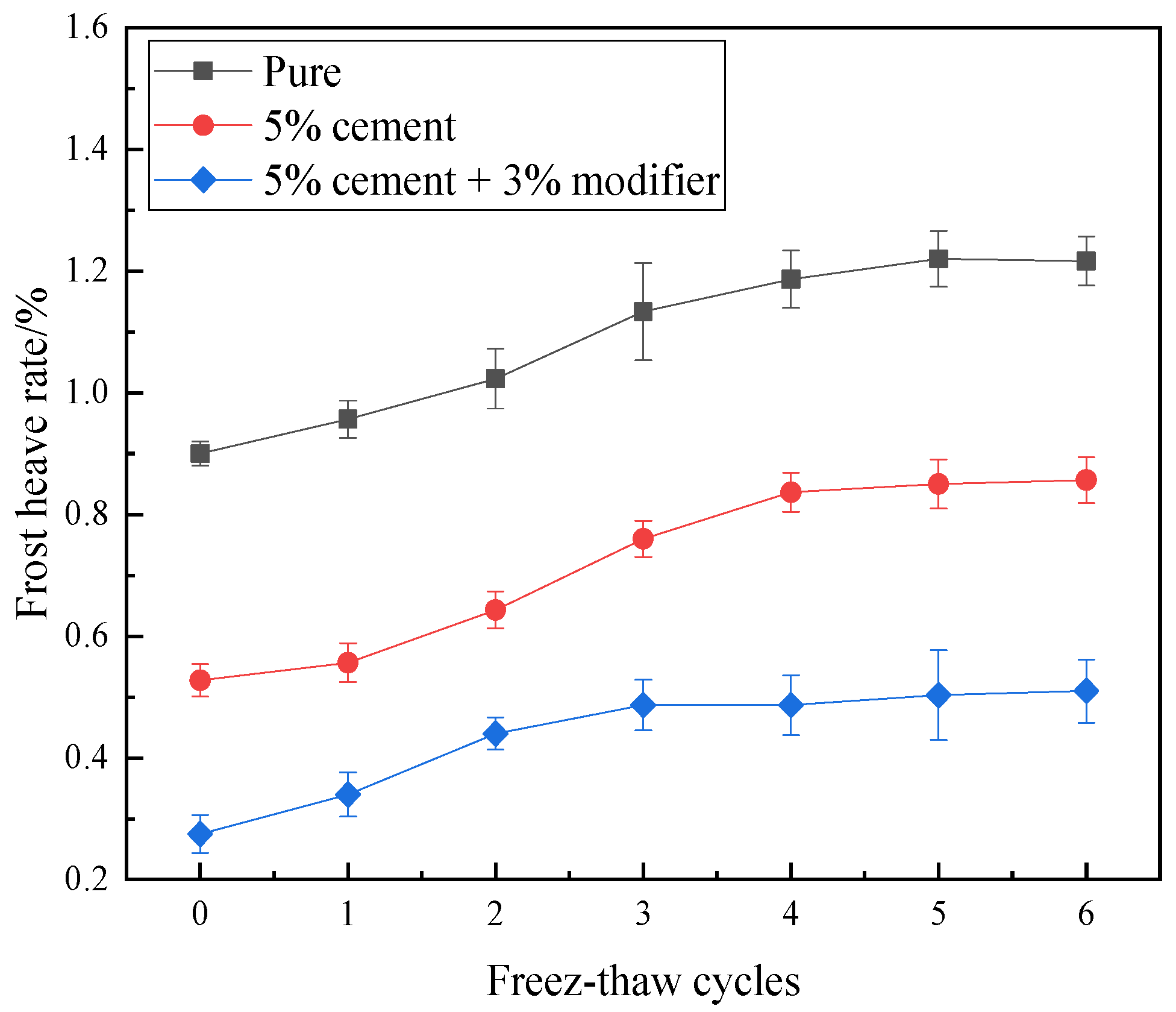
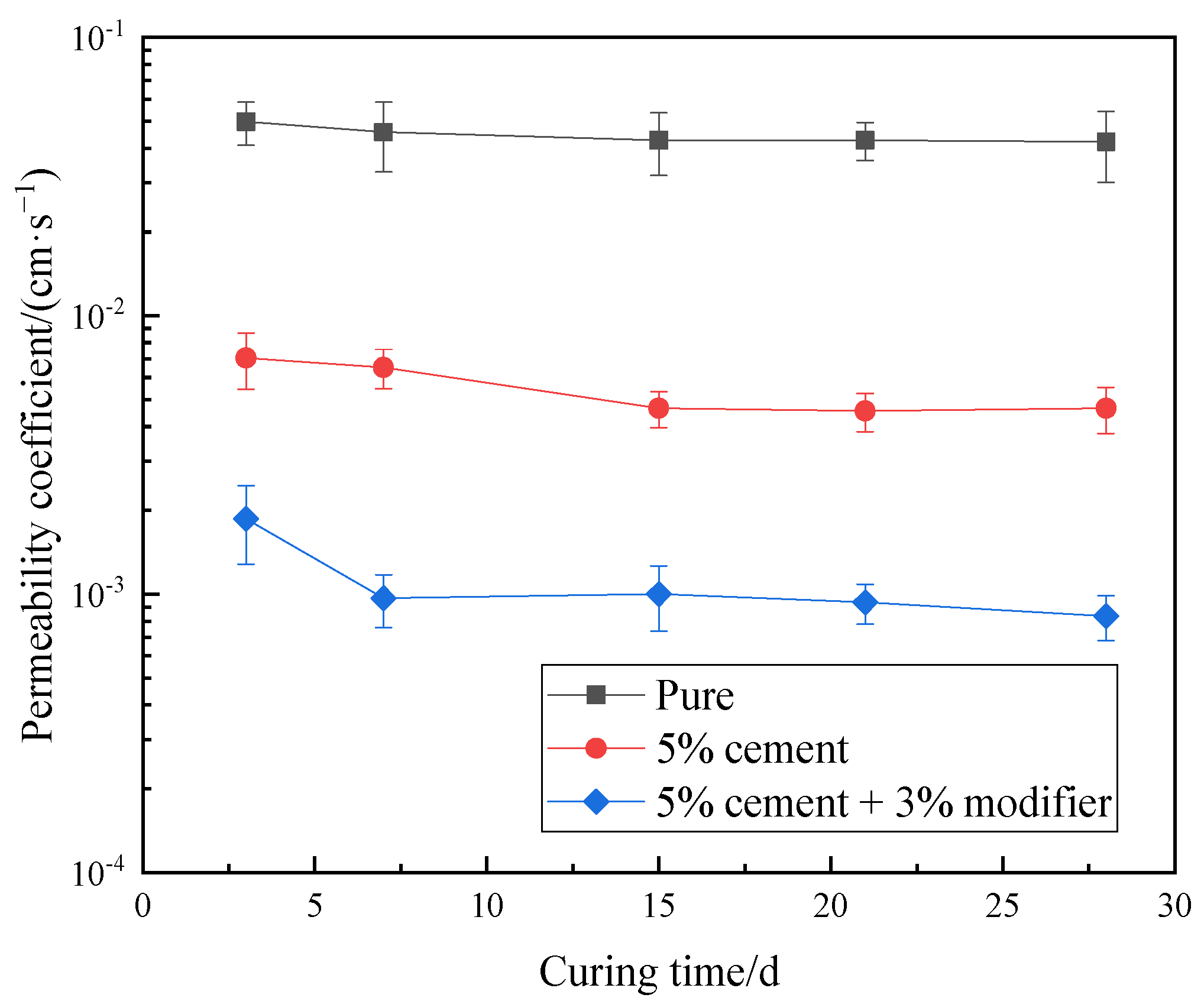
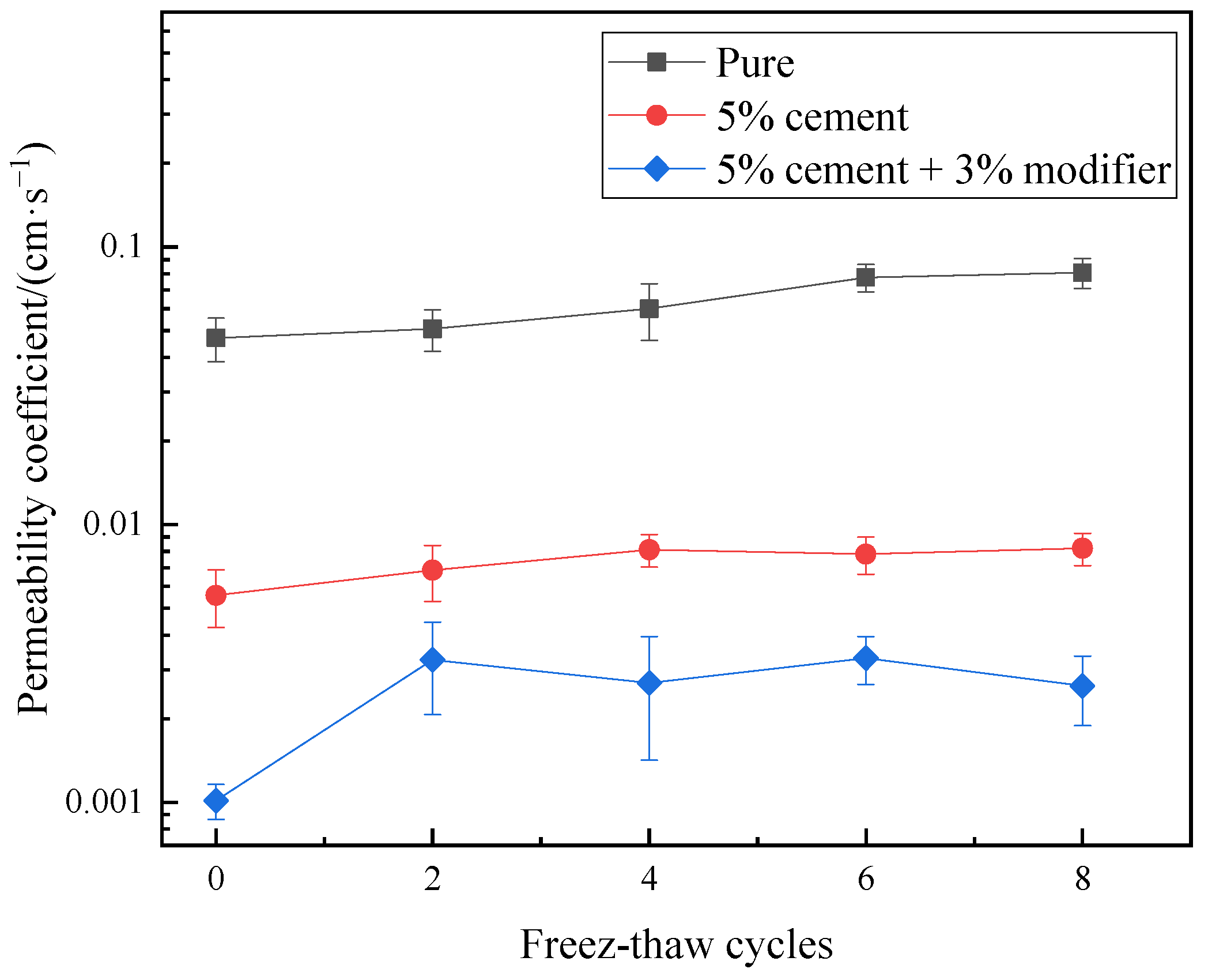
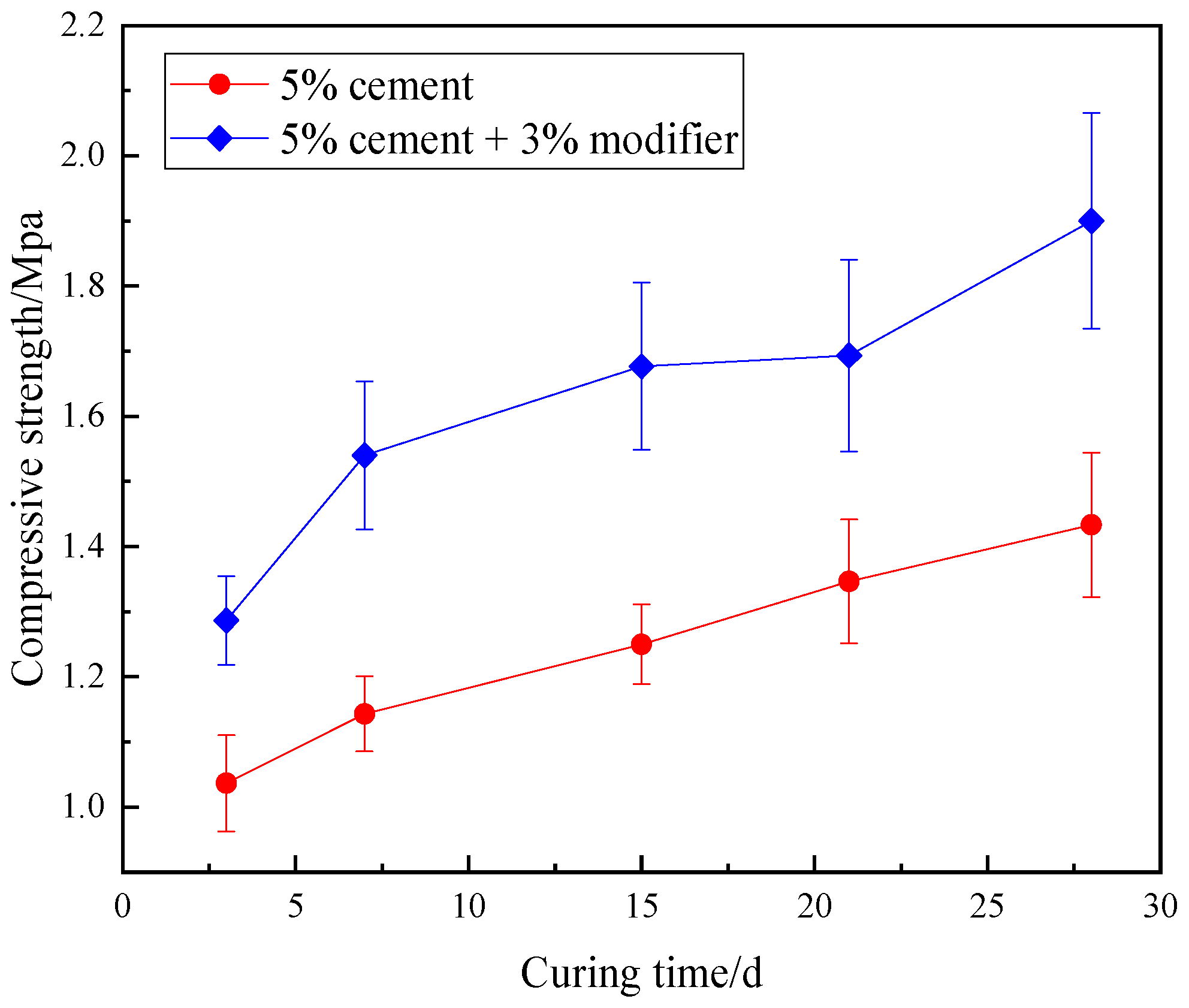
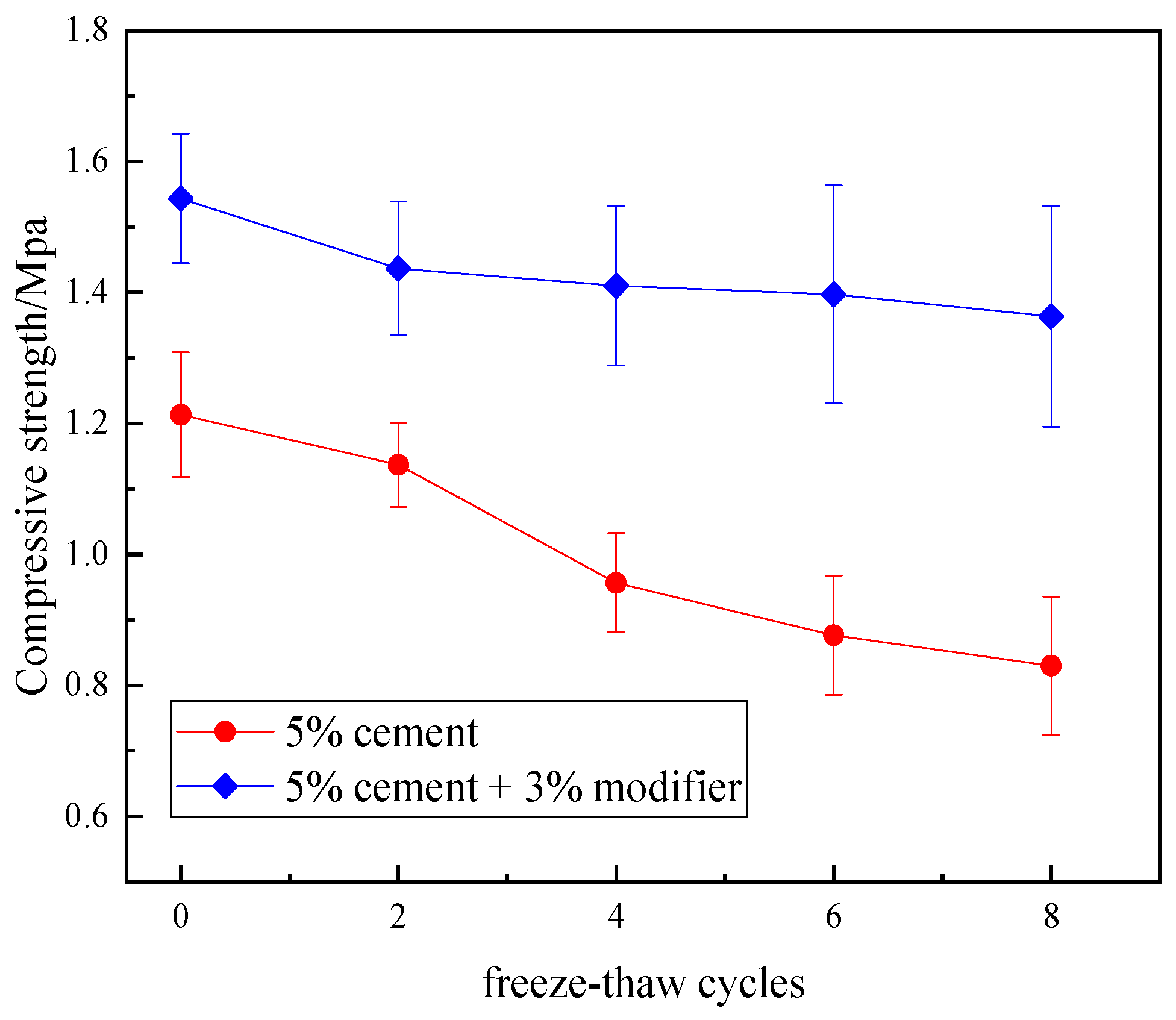

| Main Components | 3CaO·SiO2 | 2CaO·SiO2 | 3CaO·A12O3 | 4CaO·A12O3·Fe2O3 | CaSO4 |
|---|---|---|---|---|---|
| Content/% | 36~60 | 15~37 | 7~15 | 10~18 | 3~5 |
| Test Items | Modifier Dosage | Curing Time/d | Freeze–Thaw Cycles |
|---|---|---|---|
| Frost heave test | 0% | 3/7/15/21/28 | 1/2/3/4/5/6 |
| 5% cement | |||
| 5% cement + 3% modifier | |||
| Penetration test | 0% | 0/2/4/6/8 | |
| 5% cement | |||
| 5% cement + 3% modifier | |||
| Strength test | 5% cement | 0/2/4/6/8 | |
| 5% cement + 3% modifier |
Disclaimer/Publisher’s Note: The statements, opinions and data contained in all publications are solely those of the individual author(s) and contributor(s) and not of MDPI and/or the editor(s). MDPI and/or the editor(s) disclaim responsibility for any injury to people or property resulting from any ideas, methods, instructions or products referred to in the content. |
© 2023 by the authors. Licensee MDPI, Basel, Switzerland. This article is an open access article distributed under the terms and conditions of the Creative Commons Attribution (CC BY) license (https://creativecommons.org/licenses/by/4.0/).
Share and Cite
Liu, X.; Cai, D.; Yan, H.; Bi, Z.; Li, Z. Experimental Study on Engineering Characteristics of High-Speed Railway Subgrade Filler in Island Permafrost Regions. Coatings 2023, 13, 429. https://doi.org/10.3390/coatings13020429
Liu X, Cai D, Yan H, Bi Z, Li Z. Experimental Study on Engineering Characteristics of High-Speed Railway Subgrade Filler in Island Permafrost Regions. Coatings. 2023; 13(2):429. https://doi.org/10.3390/coatings13020429
Chicago/Turabian StyleLiu, Xiaohe, Degou Cai, Hongye Yan, Zongqi Bi, and Zhuqing Li. 2023. "Experimental Study on Engineering Characteristics of High-Speed Railway Subgrade Filler in Island Permafrost Regions" Coatings 13, no. 2: 429. https://doi.org/10.3390/coatings13020429
APA StyleLiu, X., Cai, D., Yan, H., Bi, Z., & Li, Z. (2023). Experimental Study on Engineering Characteristics of High-Speed Railway Subgrade Filler in Island Permafrost Regions. Coatings, 13(2), 429. https://doi.org/10.3390/coatings13020429





